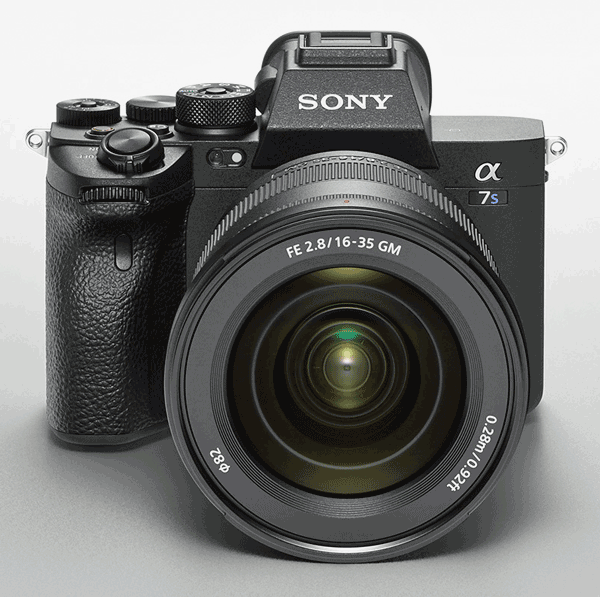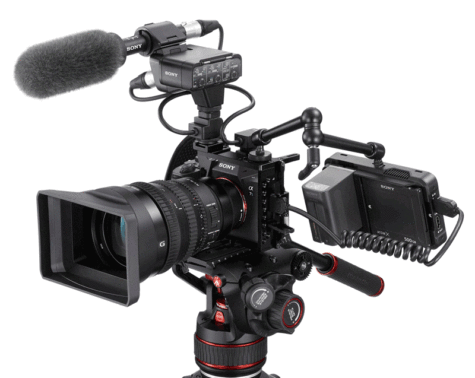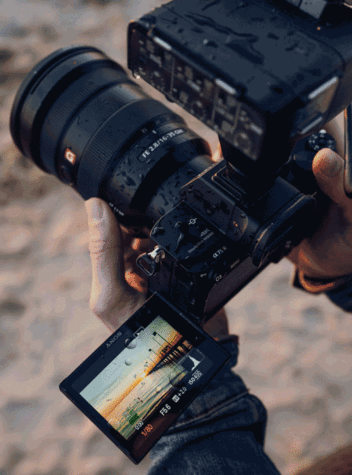Sony has announced October availability of the $6000 α7s Mark III, an extremely video-oriented full-frame mirrorless camera with an all-new Sony 12.1-megapixel BSI sensor, a massive 15-stop dynamic range, and support for 4K 10-bit 4:2:2 video. (Plus a heat sink!)
 The new models replaces the α7S II, which has been in the market for around five years. The α7s III features a 12-megapixel back-illuminated full-frame Exmor R CMOS sensor and the latest BIONZ-XR processor – with a claimed eight times more computing power than the previous BIONZ processor, and three times less rolling shutter effect. Sony is claiming a 15+ dynamic range for the camera – with some qualifications which the press release doesn’t elaborate on.
The new models replaces the α7S II, which has been in the market for around five years. The α7s III features a 12-megapixel back-illuminated full-frame Exmor R CMOS sensor and the latest BIONZ-XR processor – with a claimed eight times more computing power than the previous BIONZ processor, and three times less rolling shutter effect. Sony is claiming a 15+ dynamic range for the camera – with some qualifications which the press release doesn’t elaborate on.
‘The implementation of internal 4K video recording at both 60 and 120 frames per second with 10-bit 4:2:2 colour sampling, and external RAW recording with an astounding 16-bit colour sampling, goes beyond the requests we heard from working professionals, said Jun Yoon, head of Digital Imaging Sony ANZ. ‘The low light capability which has been the hallmark of the “S” series, is now paired with high-level cinema functions, opening new workflows and production levels for filmmakers.
‘Throw in 15+ stops of dynamic range, real-time tracking autofocus, improved colour science, improved weather sealing, redesigned heat management, improved battery life, and a world-first use of the CFexpress Type A
media card – you start to feel the gravity of progress and innovation in this camera.’

Designed primarily for professional video recording, it also offers an expanded sensitivity range, ISO 80-102,400, plus extensions to ISO 409,600 for video and from 40-409,600 for stills – effectively enabling shooting in the dark. Enhanced noise reduction processing provides a one-stop improvement in image quality, especially in the middle and high sensitivity ranges.
Sony says it has also refined gradation rendering for better looking skin tones and highlight roll-off in portraits, while a new Visible light + IR Sensor delivers more precise white balance control under artificial lighting.
It’s the first Sony camera to include the HEIF (High Efficiency Image File) format, which can record smooth 10-bit gradations and uses advanced compression technology to maintain image quality while significantly reducing file size and saving storage space. File size is roughly half that of JPEGs for the same image quality. HEIF stills can be played back on a compatible Sony HDR (HLG) TV via a direct HDMI connection. Continuous shooting is available at up to 10fps or up to 8fps in live view mode, using either the mechanical or electronic shutter. Buffer memory capacity extends to more than 1000 uncompressed RAW images.
Video capabilities include support for internal 4K video recording at both 60 and 120 frames/second with 10-bit 4:2:2 colour sampling, plus RAW video recording to an external device with 16-bit colour sampling. Unlike Canon’s ‘hottest’ new camera, the EOS R5, it doesn’t record 8K footage and downsample it. Instead, the sensor’s 12.1-megapixel resolution enables it to support full-pixel readout without pixel binning and with very slight frame cropping (1.1x) at up to 4K / 60p recorded internally. Thanks to a new heat dissipating mechanism and dual slot relay recording, Sony specifies a maximum recording time to one hour without overheating.
 (If you have no interest in videography and its mind-numbing specs, do your self a favour and skip this par): Full HD (1920 x 1080 pixels) recording is available at up to 240p with 4:2:2 chroma sub-sampling and a 10-bit colour depth. The α7S III also handles time-lapse recordings, with frame rates as slow as one second. Recording codecs have been updated with a new XAVC-HS codec (MPEG-4 HEVC/H.265) supporting internal intra-frame (All-I) compression at bit-rates up to 600 Mbps. Professional logarithmic gamma profiles include three colour gamut settings: S-Gamut, S-Gamut3, and S-Gamut3.Cine, the latter to providing easy integration with a multi-camera post-production workflow. The new camera also includes an HLG (Hybrid Log-Gamma) BT.2020 and BT.2100 profiles to deliver instant HDR content with minimal post-production. It also allows 16-bit RAW output to an external recorder via the HDMI Type-A port for additional post-production flexibility. For video on-the-go, the α7S III includes Active Mode handheld movie shooting with 5-axis in-body image stabilisation.
(If you have no interest in videography and its mind-numbing specs, do your self a favour and skip this par): Full HD (1920 x 1080 pixels) recording is available at up to 240p with 4:2:2 chroma sub-sampling and a 10-bit colour depth. The α7S III also handles time-lapse recordings, with frame rates as slow as one second. Recording codecs have been updated with a new XAVC-HS codec (MPEG-4 HEVC/H.265) supporting internal intra-frame (All-I) compression at bit-rates up to 600 Mbps. Professional logarithmic gamma profiles include three colour gamut settings: S-Gamut, S-Gamut3, and S-Gamut3.Cine, the latter to providing easy integration with a multi-camera post-production workflow. The new camera also includes an HLG (Hybrid Log-Gamma) BT.2020 and BT.2100 profiles to deliver instant HDR content with minimal post-production. It also allows 16-bit RAW output to an external recorder via the HDMI Type-A port for additional post-production flexibility. For video on-the-go, the α7S III includes Active Mode handheld movie shooting with 5-axis in-body image stabilisation.
The α7S III is the first in the 7S series with Fast Hybrid AF: phase- and contrast-detection AF with 759 phase-detection points covering 92 percent of the image sensor. The system can focus reliably in light levels down to EV-6 (night time under a half-moon, say). Real-time Tracking can be initiated by touching the subject on the screen and Real-time Eye AF engages when an eye is detected. Sony reckons the latter provides 30 percent better detection performance, even when the subject isn’t looking at the camera. Seven AF Transition Speed settings are available, making it easy to easily create rack-focus transitions. Five AF Subject Shift Sensitivity settings are also provided, along with Touch Tracking. Touch Focus can be used in manual focus mode as well as remotely from the Imaging Edge Mobile app.
The camera has a redesigned grip, a more prominent REC button, improved (sensor) dust removal, and better dust and moisture resistance. A new side opening, 3-inch 1.44 million-dot touch panel vari-angle rear LCD screen facilitates using the camera for gimbal-mounted shots and complicated angles. A new 0.64 type Quad-XGA OLED electronic viewfinder provides the world’s first 9.44 million-dot (approx.) display with a 100 fps refresh rate. The EVF has 0.9x viewfinder magnification, 41-degree diagonal field of view and comfortable 25mm eyepoint; is also dust, fog and moisture resistant; and has switchable modes for different subject types.
It’s the first camera with two CFexpress Type A-compatible media slots, which also support UHS-I and UHS-II SDXC/SDHC cards. The dual slots can be set to relay mode for extended continuous recording of even high bit rate data. A revised menu structure provides easier navigation and separate settings can be stored for stills and movie shooting for quick transition between the two. The new camera is also the first in the series to support USB Power Delivery (PD).
Catering for photo and video journalists and sports shooters, the α7S III provides several advanced connectivity options, including 5GHz /2.4GHz wireless LAN (IEEE 802.11ac) plus MIMO (multiple-input and multiple-output) to improve communication quality by using multiple antennas. It also carries new USB tethering support. A USB Type-C connector that supports fast SuperSpeed USB 5Gpbs (USB 3.2) data transfer is provided. An optional USB-C-to Ethernet adapter is available for FTP functionality.
The new Alpha 7S III will be available in Australia from early October 2020 at an RRP of $5999 (body only).
The official press release contains a lot more detail – including just short of 30 separate footnotes:
Press Release – Sony Alpha 7S III
– And if you just can’t get enough on arguably the best video camera ever in a still camera body, there’s this:
Sony A7SIII ‘Product Flash’
(Thanks to Adhesive PR, Sony’s PR consultancy, for assistance in preparing this story.)





Be First to Comment